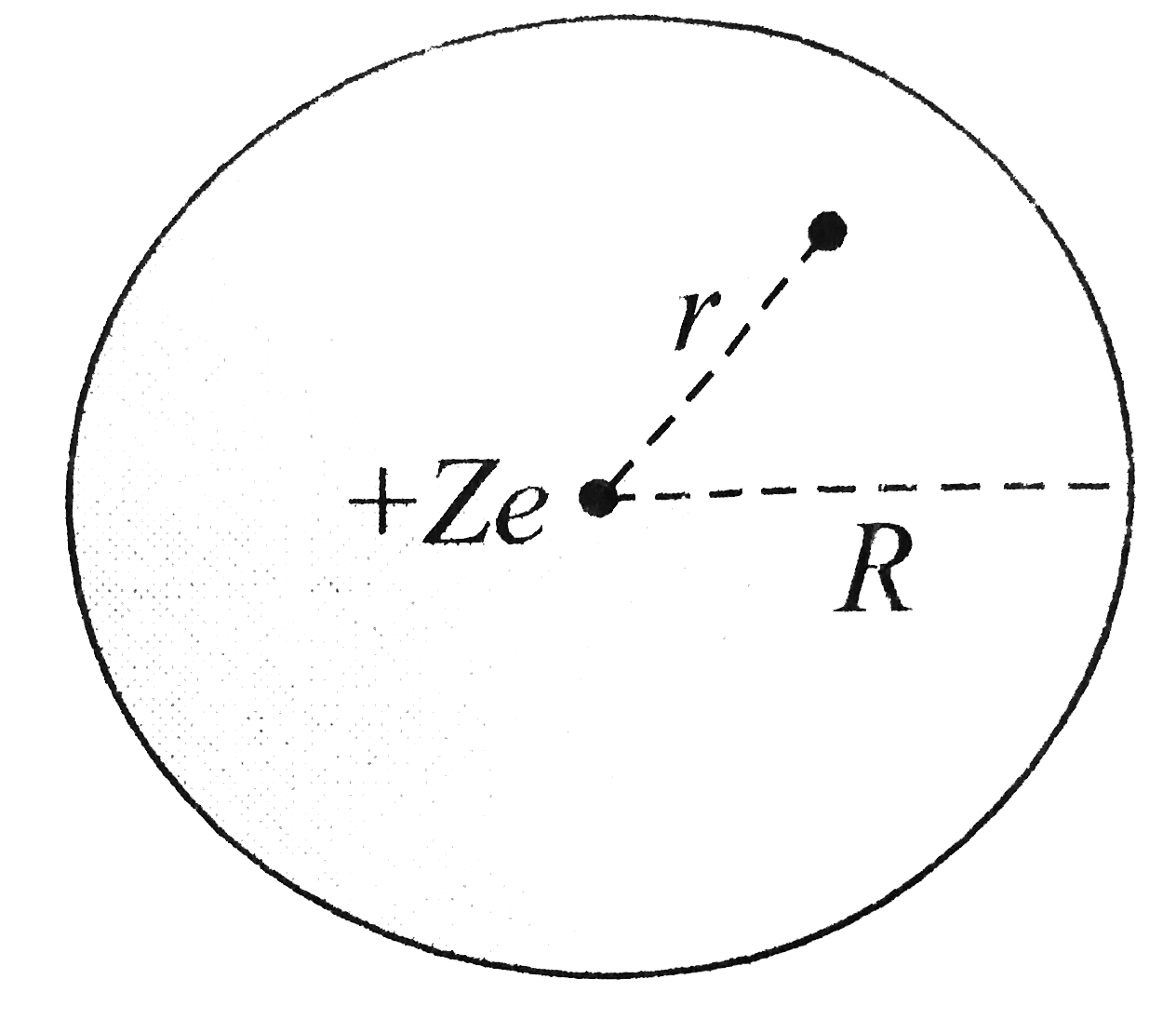An early model for an atom considered it to have a positivelly charged point nucleus of charge +Ze surrounded by a uniform density of negative charge up to a radius R. The atom as whole is neutral. For this model , what is the electric field at a distance r from the nucleus when
r<R
r=R ?Use Gauss's theorem
Let as shown in positive charge at the centre of the atom be +Ze and let density of negative charge be ρ, such that total negative charge 43πR3ρ=−Ze
⇒ ρ=3Ze4πR3
For any point P situated at a distance r (r<R) from the nucleus considering a sphere of radius r as the Gasussian surface , we have
Charged enclosed
q=(+Ze)+ negative charge enclosed within the sphere of radius r
⇒ q=Ze+43πR3ρ=Ze−Zer3R3=Ze[1−r3R3]
∴ Flux on Gaussian surface ϕ∈=E4πr2=1∈0q=Ze∈0[1−r3R3]
⇒ E= Ze4π∈0[1r2−rR3]
(b) For any point P situated on or outside the atom (i.e., ≥R) total charge enclosed
q=(+Ze)+(−Ze)=0
Hence ϕ∈=E.4πr2=1∈0(0)=0
⇒ E=0
(##U_LIK_SP_PHY_XII_C01_E10_029_S01.png" width="80%">
Topper's Solved these Questions
- ELECTRIC CHARGES AND FIELDS BOOK - U-LIKE SERIESCHAPTER - ELECTRIC CHARGES AND FIELDS EXERCISE - LONG ANSWER QUESTIONS -II
9 Videos
- ELECTRIC CHARGES AND FIELDS BOOK - U-LIKE SERIESCHAPTER - ELECTRIC CHARGES AND FIELDS EXERCISE - SELF ASSESSMENT TEST (SECTION-A)
5 Videos
- ELECTRIC CHARGES AND FIELDS BOOK - U-LIKE SERIESCHAPTER - ELECTRIC CHARGES AND FIELDS EXERCISE - SHORT ANSWER QUESTIONS
29 Videos
- DUAL NATURE OF RADIATION AND MATTERBOOK - U-LIKE SERIESCHAPTER - DUAL NATURE OF RADIATION AND MATTEREXERCISE - SELF ASSESSMENT TEST SECTION-C (VERY SHORT ANSWER QUESTIONS)
3 Videos
- ELECTROMAGNETIC WAVESBOOK - U-LIKE SERIESCHAPTER - ELECTROMAGNETIC WAVESEXERCISE - SELF ASSESSMENT TEST (SECTION C)
1 Videos
Similar Questions
According to early model of an atom,the atom is considered it to have a positively charged point nucleus of charge Ze surrounded by a uniform density of negative charge up to a radius R. The atom as a whole is neutral. The electric field at a distancer from the nucleus is (r<R)

View SolutionAccording to early model of an atom,the atom is considered it to have a positively charged point nucleus of charge Ze surrounded by a uniform density of negative charge up to a radius R. The atom as a whole is neutral. The electric field at a distancer from the nucleus is (r<R)

View Solution
Knowledge Check
An early model for an atom considered to have a positively charged point nucleus of charge Ze surrounded by a uniform density of negative charge up to a radius R. The atom as a whole is neutral. For this model, what is the electric field a distance r from the nucleus, where r>R ?
A14πε0Zer2B14πε0ZeR2C14πε0Zer2−R2D0According to early model of an atom, the atom is considered it to have a positively charged point nucleus of charge Ze surrounded by a uniform density of negative charge up to a radius R. The atom as a whole is neutral. The electric field at a distance r from the nucleus is (r<R)
 AZe4πε0[rR3−1r2]BZe4πε0[rR3+1r2]CZe4πε0[1r2−rR3]DZe4πε0[1r3−rR2]
AZe4πε0[rR3−1r2]BZe4πε0[rR3+1r2]CZe4πε0[1r2−rR3]DZe4πε0[1r3−rR2]A hallow metal sphere of radius R is uniformly charged. The electric field due to the sphere at a distance r from the centre:
AIncreases as r increases for r<Rand for r>RBZero as r increases for r<R, decreases as r increases for r>RCZero as r increases for r<R , increases as r increases for r>RDDecreases as r increases for r<Rand for r>R
An early model for an atom considered it to have a positively charged point nucleus of charge Ze, surrounded by a uniform density of negative charge upto a radius R. The atom as a whole is neutral. The electric field at a distance r from the nucleus is (r < R)

View SolutionAccording to early model of an atom,the atom is considered it to have a positively charged point nucleus of charge Ze surrounded by a uniform density of negative charge up to a radius R. The atom as a whole is neutral. The electric field at a distancer from the nucleus is (r<R)

View SolutionAccording to early model of an atom,the atom is considered it to have a positively charged point nucleus of charge Ze surrounded by a uniform density of negative charge up to a radius R. The atom as a whole is neutral. The electric field at a distancer from the nucleus is (r<R)

View SolutionState Gauss 'law in electrostatics.
Consider an overall neutral sphere of radius R. This sphere has a point charge +Q at its centre and this positive charge is surrounded by a uniform density ρ of negative charges up to a radius R.
Use Gauss, law to obtain expression for the electric field , of this sphere , at a point distant r, from its centre ,where
r<R,
r>R
Show that these two expressions give identical results, for the electric field, at r= R.
View SolutionIf the potential at the center of a uniformly charged sphere of radius R is V then electric field at a distance r from the center of sphere will be (r<R) : -

View Solution
